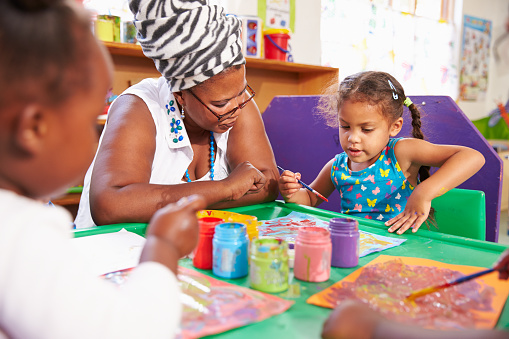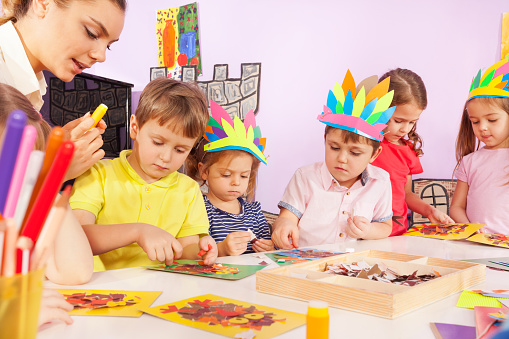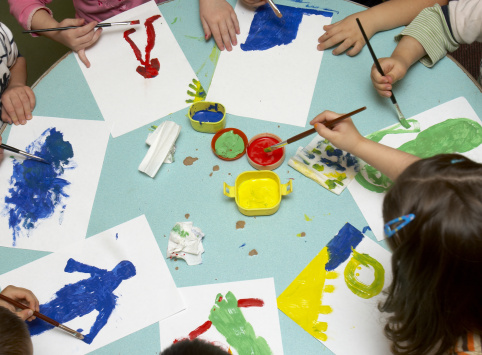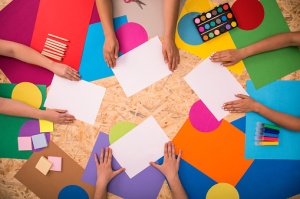Teacher-directed vs. child-directed art has long been a hot topic in early childhood. Teachers and providers usually understand the importance of keeping art projects age-appropriate and child-focused, but many parents pressure them to offer crafts that are cute, theme-related, and showcase-worthy. Some teachers avoid all mass-produced crafts while others struggle with freestyle art because some children do not stay engaged long without specific instruction.
Example: The child brings home a sheet and proudly shows it to her mom. Her mother looks at the sheet and sees…a mess. She murmurs something polite like, “That’s nice, Honey.” The artwork never makes it to the fridge because it doesn’t look like anything to showcase.
Let’s first address why art matters in early childhood:
- Art allows for self-expression. Children can showcase self-direction, preferences, and abilities through the process of creation.
- Art fosters creativity. Children can show inventiveness and creativity when they are allowed to create freely.
- Art increases global and cultural awareness. Art can be used to teach children about other communities and cultures throughout the world.
- Art strengthens awareness of symbols. Art may provide opportunities for children to recognize that symbols convey meaning (geometric shapes, numerals, and print).
- Art engages problem solving and critical thinking. Through art, children begin asking why, where, how, and what questions and will seek answers through exploration.
- Art allows for exploration of emotions and feelings. Children can relay and manage feelings by using art as an outlet.
Art projects have a purpose. Drawing and cutting activities require bilateral coordination, which is the ability to use both hands at the same time. These types of activities also allow children to practice and strengthen fine motor skills. Waiting for glued projects to dry provides an opportunity for children to practice patience and self-regulation. Completing a project can give children a sense of accomplishment.
So how can providers, teachers, and parents make sure the art they offer is beneficial?
 Art skills fall on a developmental continuum. Very young children are often more interested in exploring how to use art techniques and materials. They may not have the cognitive readiness to aim toward creating a particular object. As they mature, they begin to show a desire to create something that is recognizable. For example, a toddler may dip a brush in paint and then touch the painted brush with her fingers to feel it. She may hold the brush with a fist and then swipe it on the paper without conscious thought of the result. A year later the same child may begin to immediately smear paint onto a paper without needing to first touch it. By the end of her preschool years, the child uses the paint with purpose to create a picture.
Art skills fall on a developmental continuum. Very young children are often more interested in exploring how to use art techniques and materials. They may not have the cognitive readiness to aim toward creating a particular object. As they mature, they begin to show a desire to create something that is recognizable. For example, a toddler may dip a brush in paint and then touch the painted brush with her fingers to feel it. She may hold the brush with a fist and then swipe it on the paper without conscious thought of the result. A year later the same child may begin to immediately smear paint onto a paper without needing to first touch it. By the end of her preschool years, the child uses the paint with purpose to create a picture.
Art projects should allow for all children to participate, regardless of where they fall on the continuum. Adaptations and extensions can be made so all children can create at their level of capability.
What is teacher-directed art compared to child-directed art, and what are the pros and cons?
Teacher-Directed Art:
 Teacher-directed art involves projects that are structured to have a specific result. The teacher gives directions that the children follow. At the end of the activity, all the projects may look extremely similar.
Teacher-directed art involves projects that are structured to have a specific result. The teacher gives directions that the children follow. At the end of the activity, all the projects may look extremely similar.
Pros:
- Teacher-directed projects can expose children to new art processes and help develop skills that the children can later apply to their child-directed creations.
- Just as children need to learn basic skills in math, science, literacy, and other developmental areas, they need opportunities to learn the basics of art.
- Theme-related projects reinforce what children are learning and can help the children share what they have learned with their families.
- Children who struggle with their creativity may spend more time on the project if they are given structure and guidance.
- Older children can benefit from the practice of listening to and following directions step by step, which is something they will need to be able to do in kindergarten and elementary school.
Cons:
- Children may be required to use the same exact materials.
- The children’s projects may look very similar, if not exactly the same.
- Some children may not be developmentally ready to complete certain steps, such as cutting or drawing specific objects.
- Creativity may be limited through direct instruction.
- Teachers may focus more on the finished product rather than allowing children to enjoy the process of creating.
Child-Directed Art:
 Child-directed art involves projects that are unstructured and completely child-centered. The materials are placed in front of the children, and children are encouraged to use the materials as they wish to create a work of art.
Child-directed art involves projects that are unstructured and completely child-centered. The materials are placed in front of the children, and children are encouraged to use the materials as they wish to create a work of art.
Pros:
- Child-directed art allows children to take an activity to their level of capability.
- The children are able to express their current emotions through their artwork.
- There are no steps that are developmentally inappropriate for individual children.
- Children and parents know the art was done 100% by the child.
- Children can focus on the process of art rather than on a finished product.
Cons:
- Children who struggle with creativity may struggle to stay engaged, therefore finishing much earlier than intended
- Some skills such as cutting or pencil grip may wane because specific practice isn’t enforced.
- The resulting art may look messy and unrecognizable. Many teachers may hesitate to display the artwork because it doesn’t conform to their expectations.
- Parents might be disappointed that they have nothing recognizable to decorate the fridge at home.
So is there a right or wrong way?
Older children may crave more steps with more advanced instruction while young children need the freedom to explore with the materials rather than create a product. All age groups should have a way to express their creativity. Teacher-facilitated art may provide the best of both styles. In teacher-facilitated art, the child may be given some direction while being encouraged to create art that showcases his skills and creativity.
Here are some tips to help facilitate a successful art project:
- Pose an idea at the beginning of a project to help spark ideas. For example, lay the paper and materials on the table as you say, “I would love to decorate our setting for spring. How could you use these materials to make your paper look like spring?”
- When completing freestyle art projects, share the process of the project with parents and family members. “Today we wanted to see what would happen if we dripped paint on a vertical piece of cardboard. The children were mesmerized as the paints ran down the front. We made predictions whether or not any of the drips of paint would make it to the bottom. As you can see, four drips made it all the way!”
- If allowed, take photographs of the children as they work and display where families can see the looks of concentration on their faces.
- For older children, offer instructions that allow for personal interpretation. For example, you might say, “Next, we’re going to add stems to the flowers. What could you use as stems? Once you choose a material that could be used as a stem, cut it to fit and glue it to the page.” If you offer materials such as ribbon, sequins, yarn, or Wikki Stix, the children can choose any of the options to serve as stems.
- Encourage children to talk at home about the materials and tools used to create and what the experience was like using them. For example, if you have children try fingerpainting with mud, the children might talk about how cold the mud felt or that he noticed a gritty feel. Once hearing an explanation, families might be more apt to display the artwork, knowing what a great experience the children had while creating.
 Allow children to cut or tear even if it isn’t perfect. Many providers are tempted to cut for children to get a cleaner look. Instead, praise the children for her efforts and persistence.
Allow children to cut or tear even if it isn’t perfect. Many providers are tempted to cut for children to get a cleaner look. Instead, praise the children for her efforts and persistence.- Offer supplies and materials in assorted colors, shapes, and sizes so projects are not all the same. Invite children to choose their preferences among the provided items.
- When asked to draw or color something specific, be careful not to specify a color or what exact objects should be drawn. For example, when asking children to color grass at the bottom of the page, do not tell them to color the grass green. Allow them to decide what color the grass will be. Anything goes with art!
Remember that the purpose of an art project is to allow children to manipulate the materials, use their imaginations, strengthen fine motor skills, and explore emotion. As you display artwork in your setting, ask yourself if these reasons are visible in the creations on the wall.
Back to blog listing